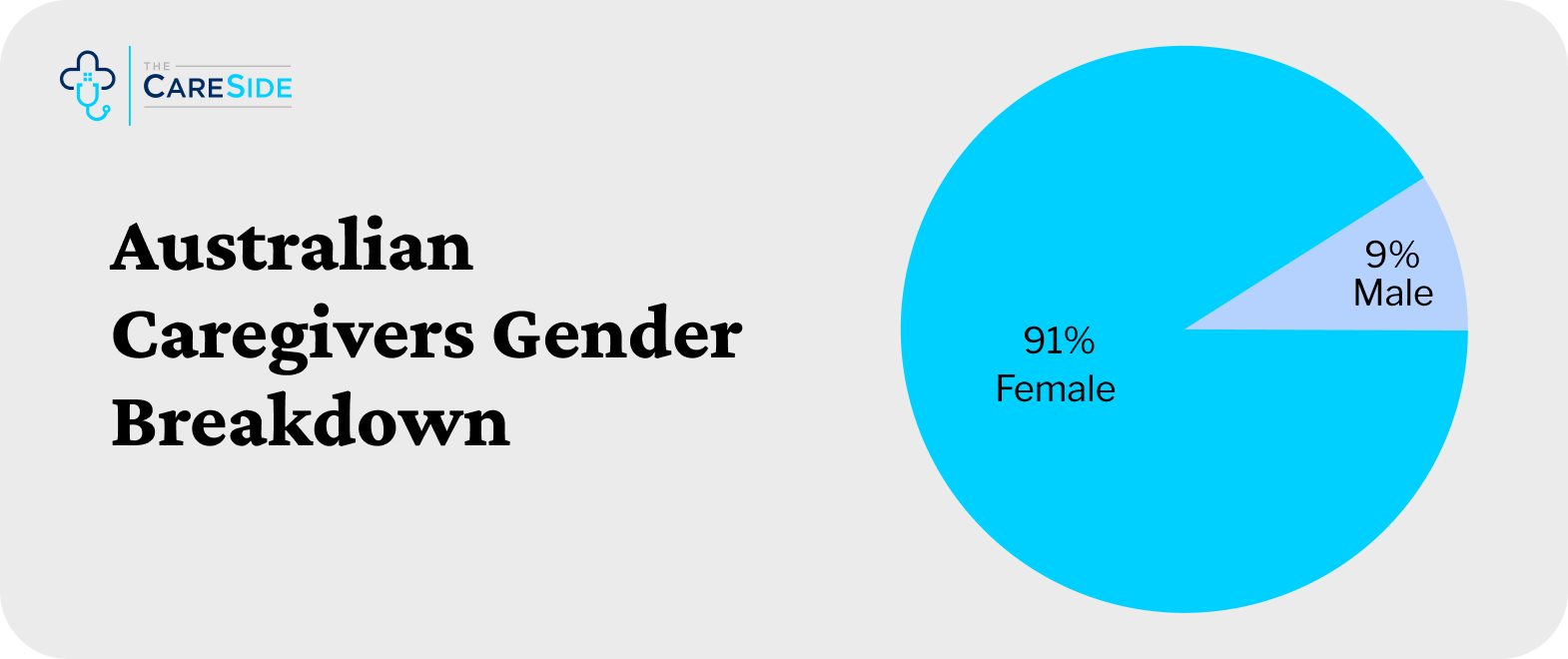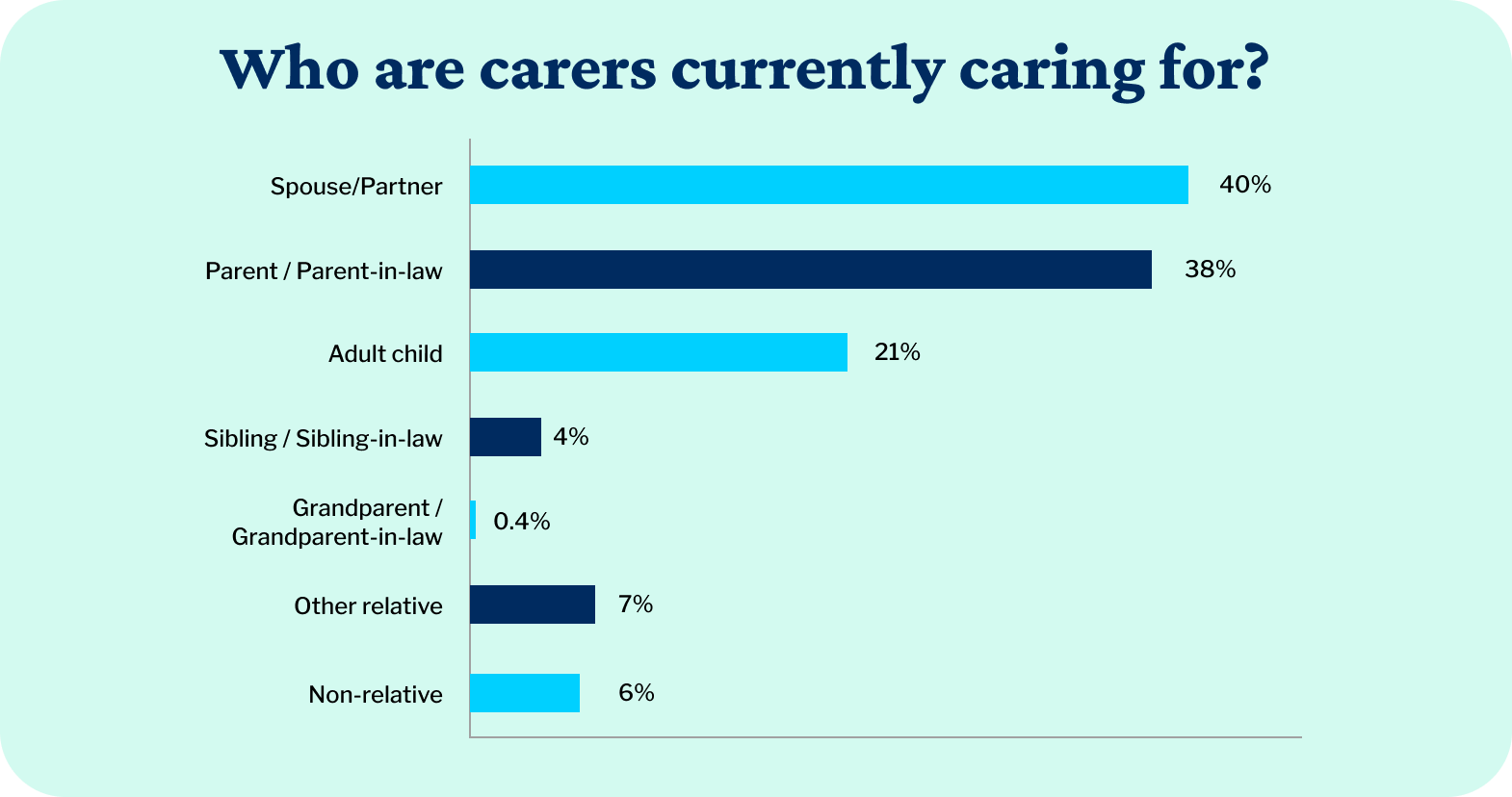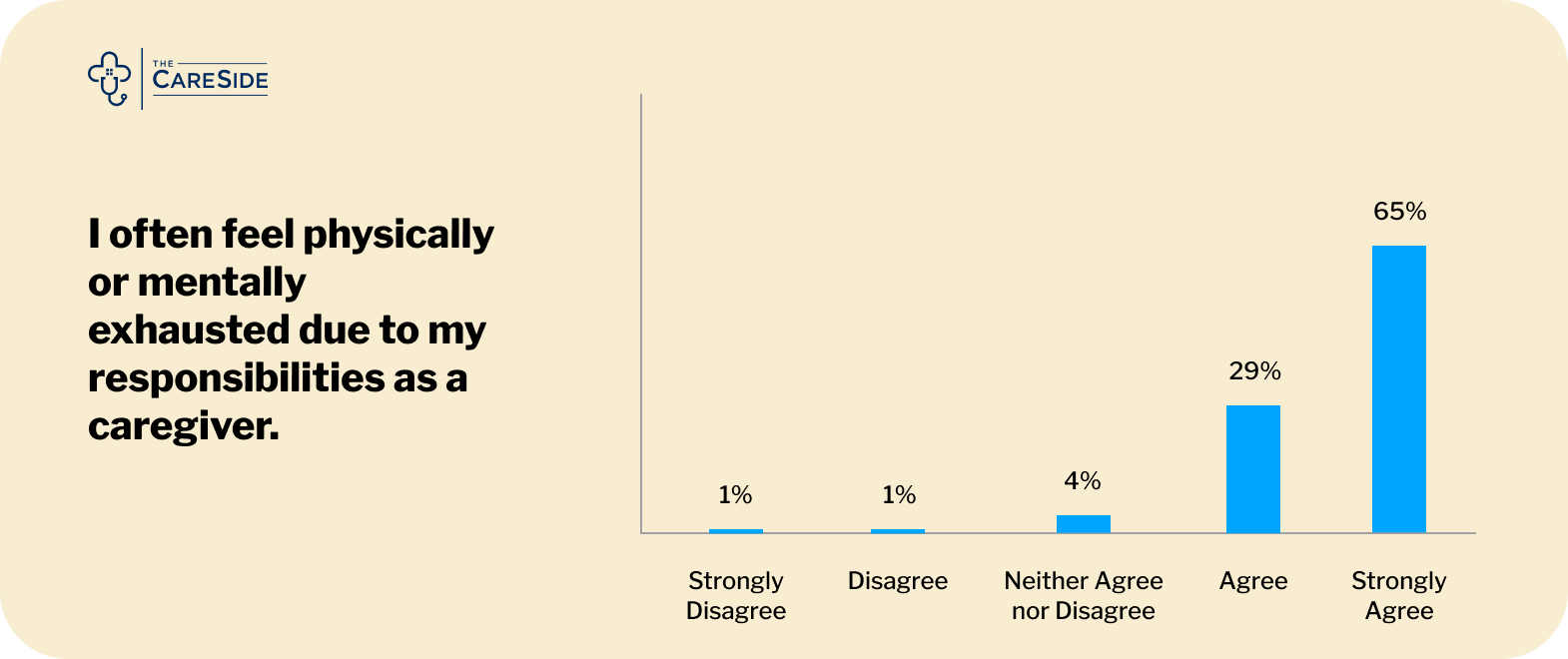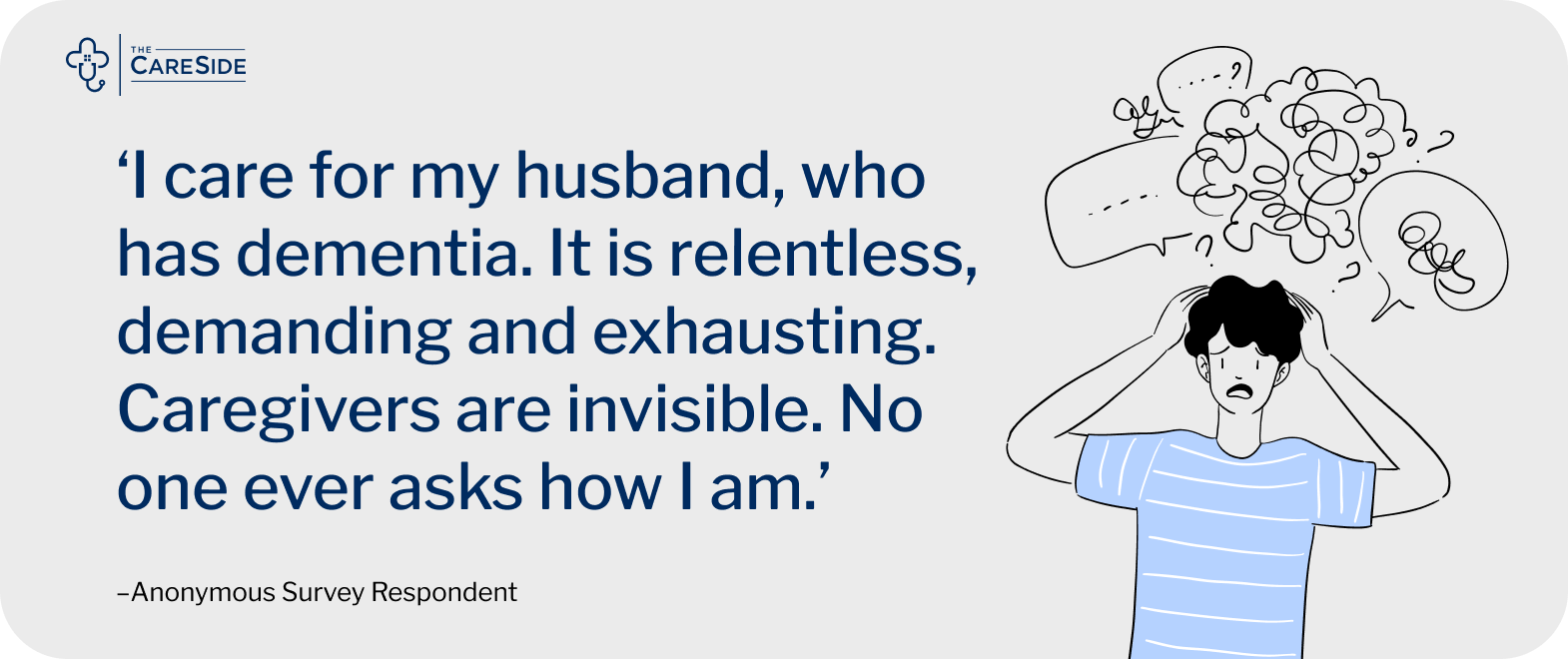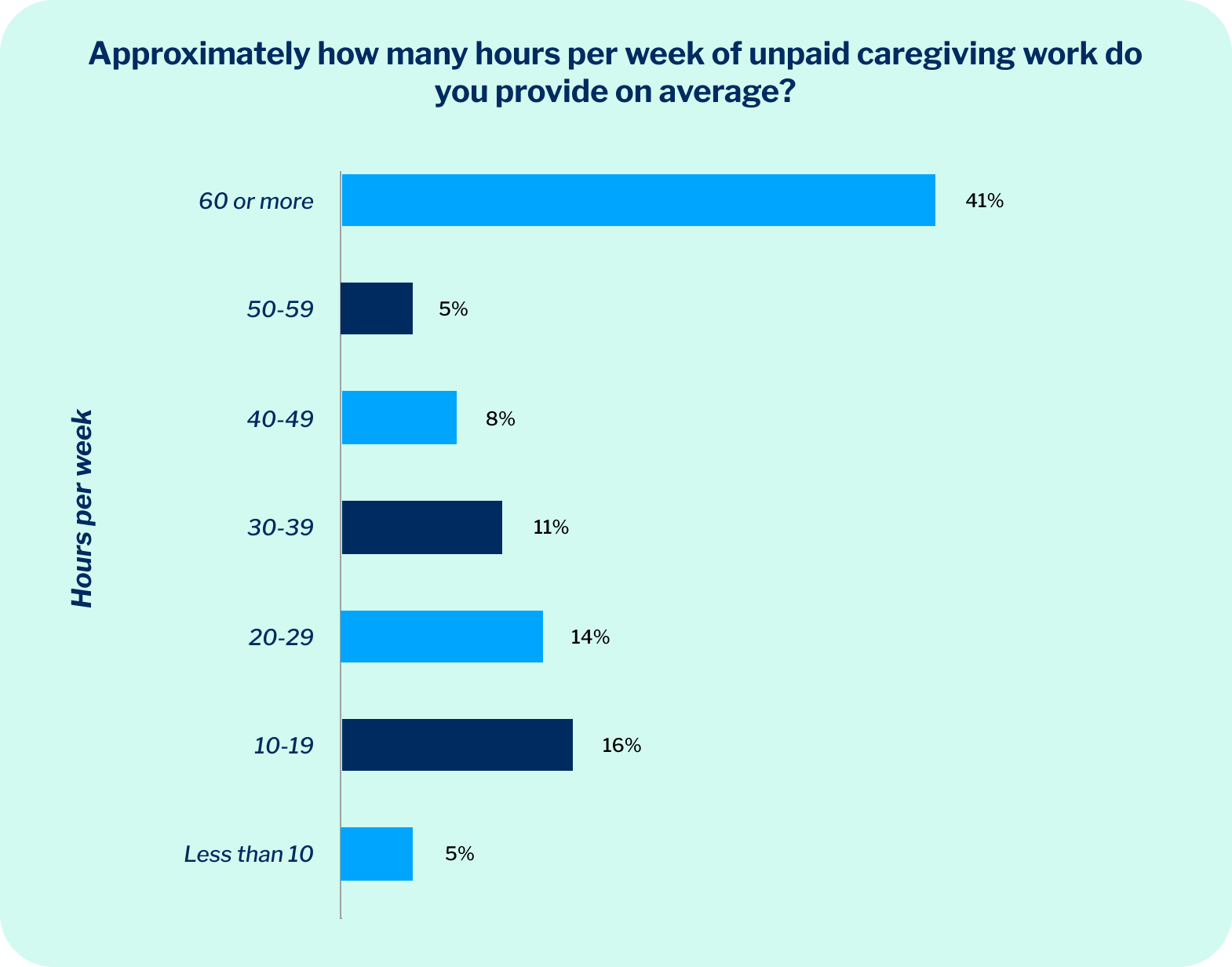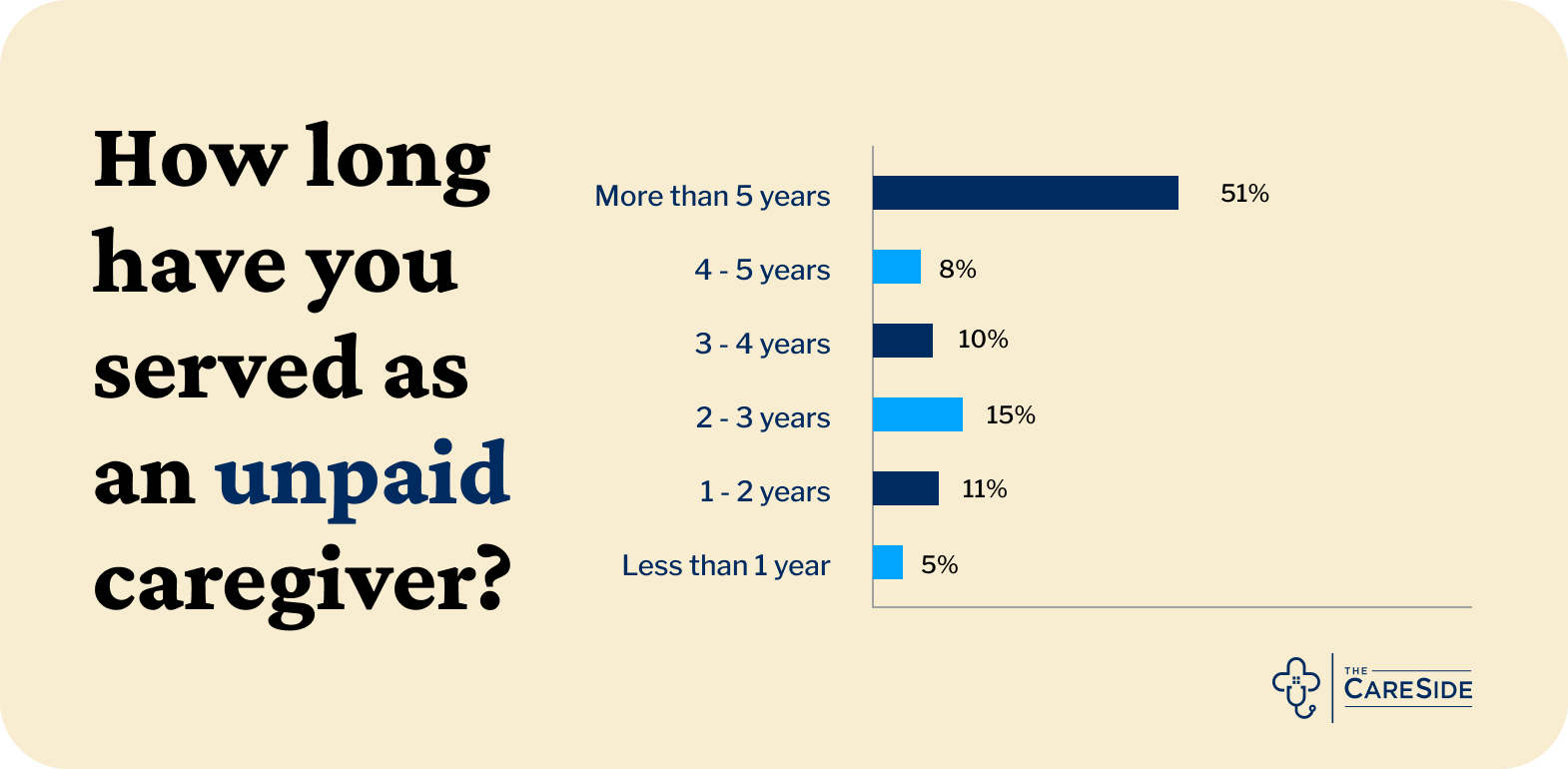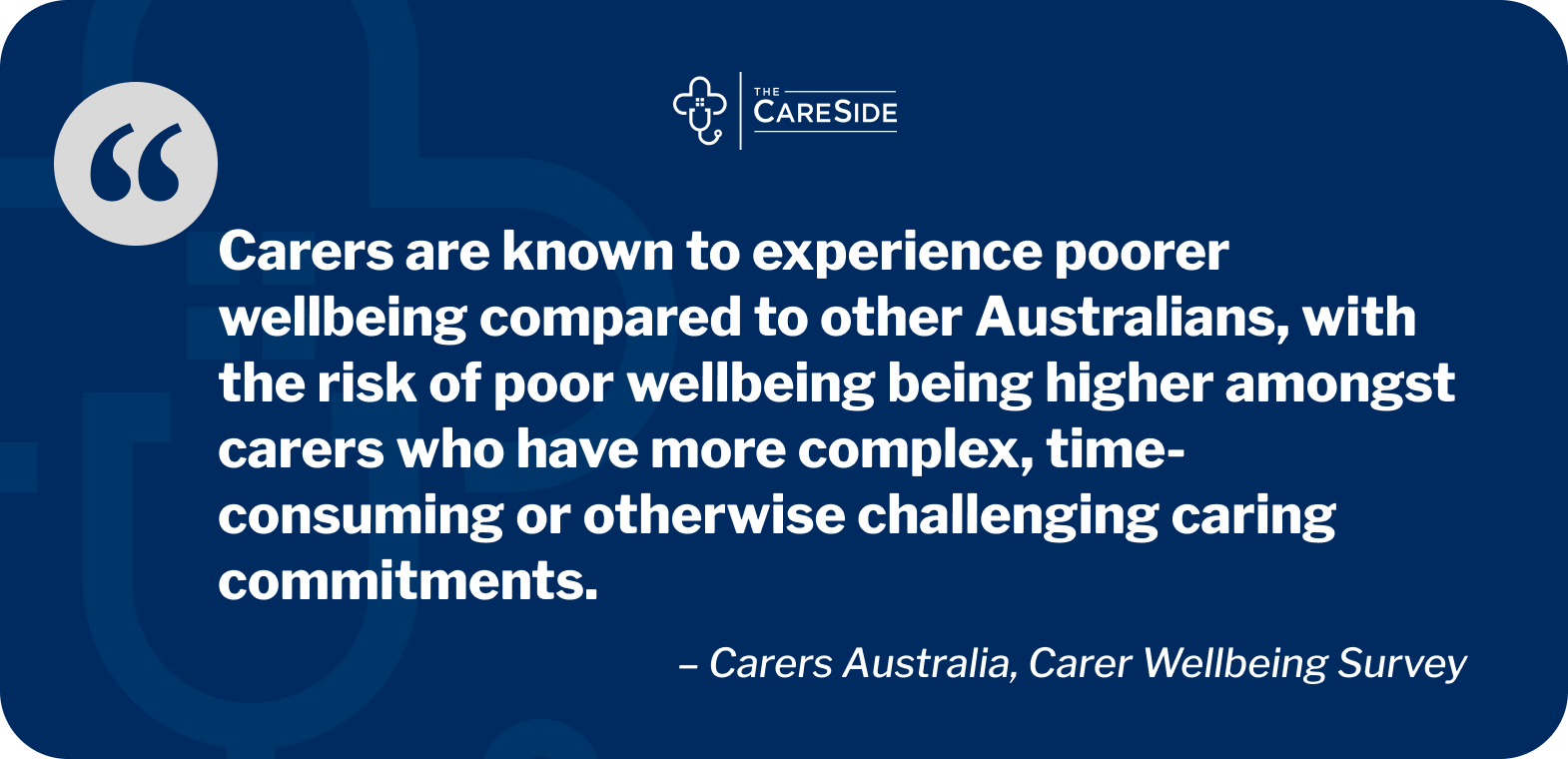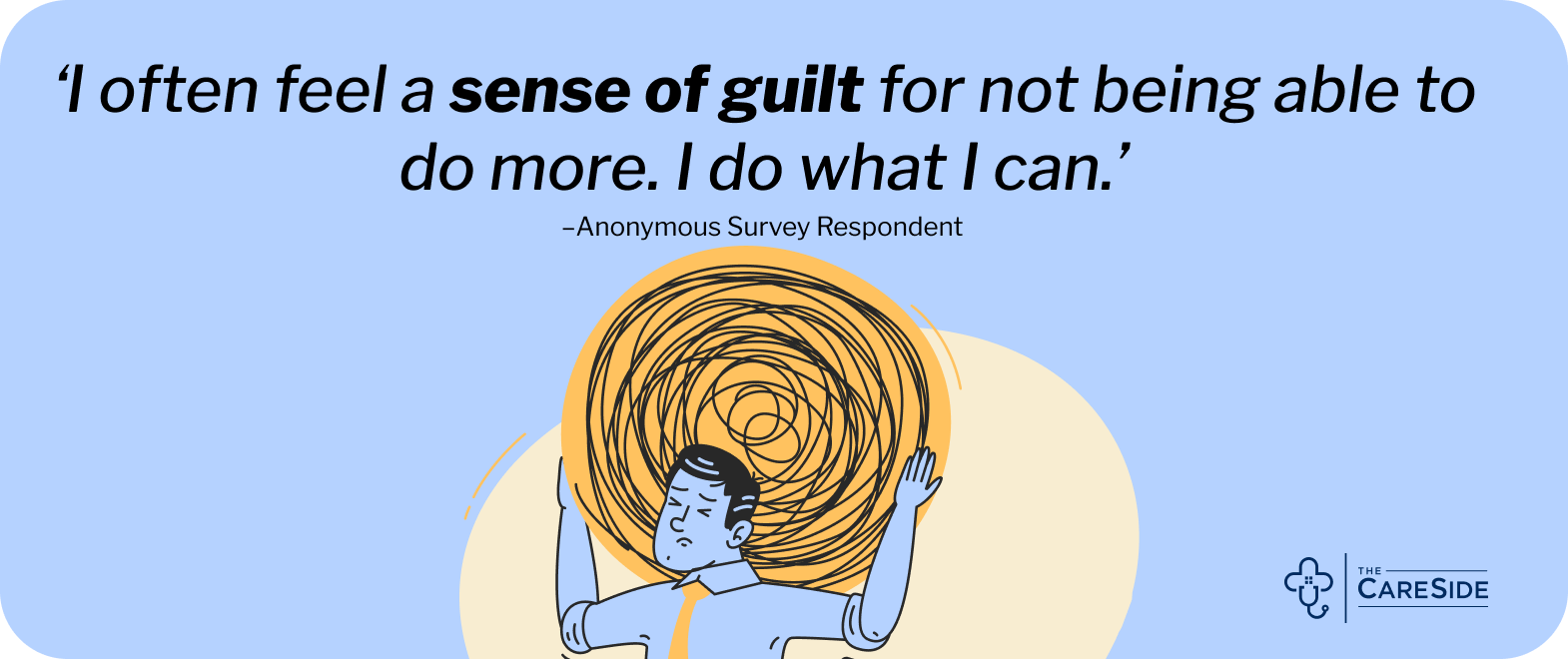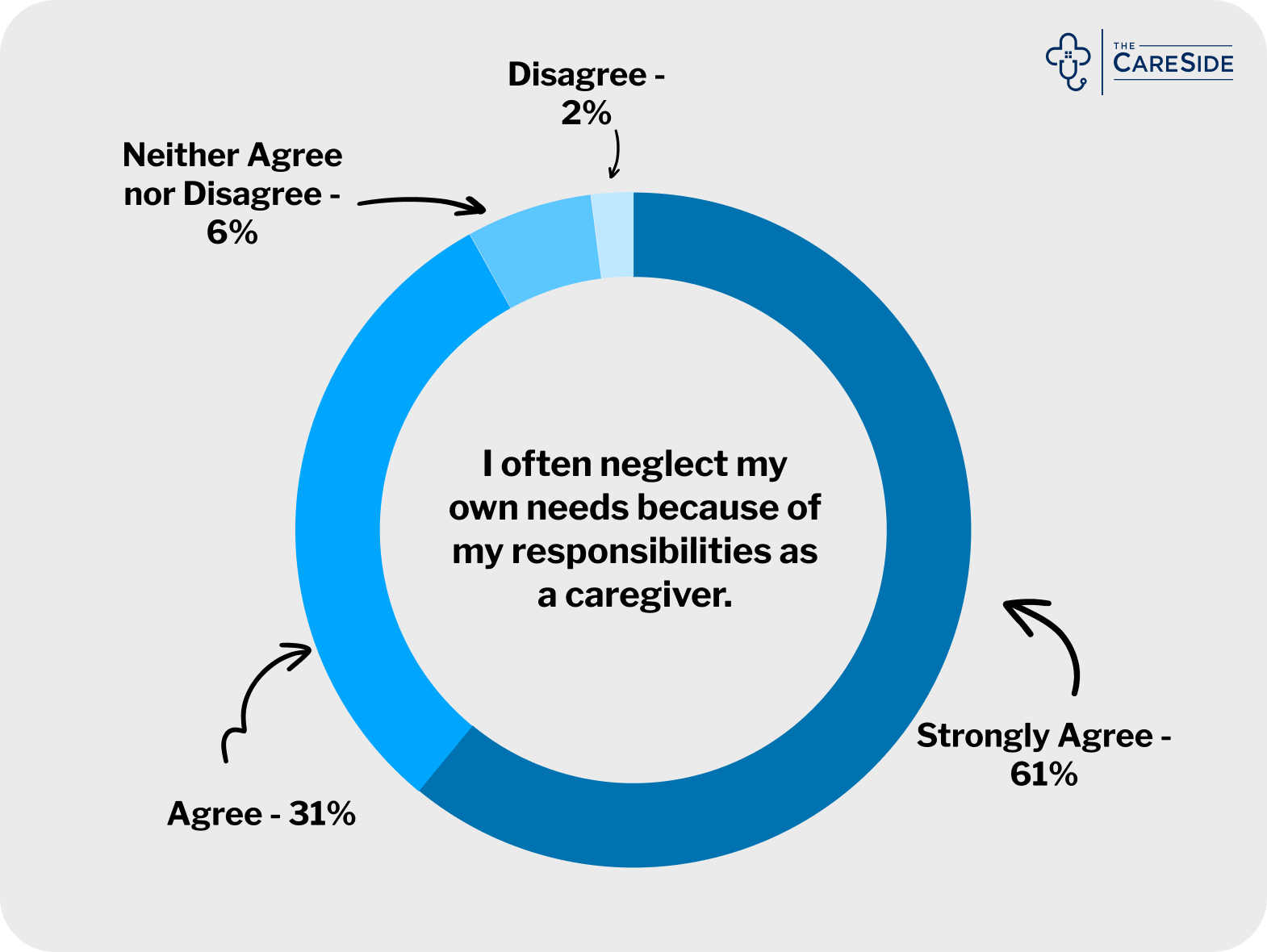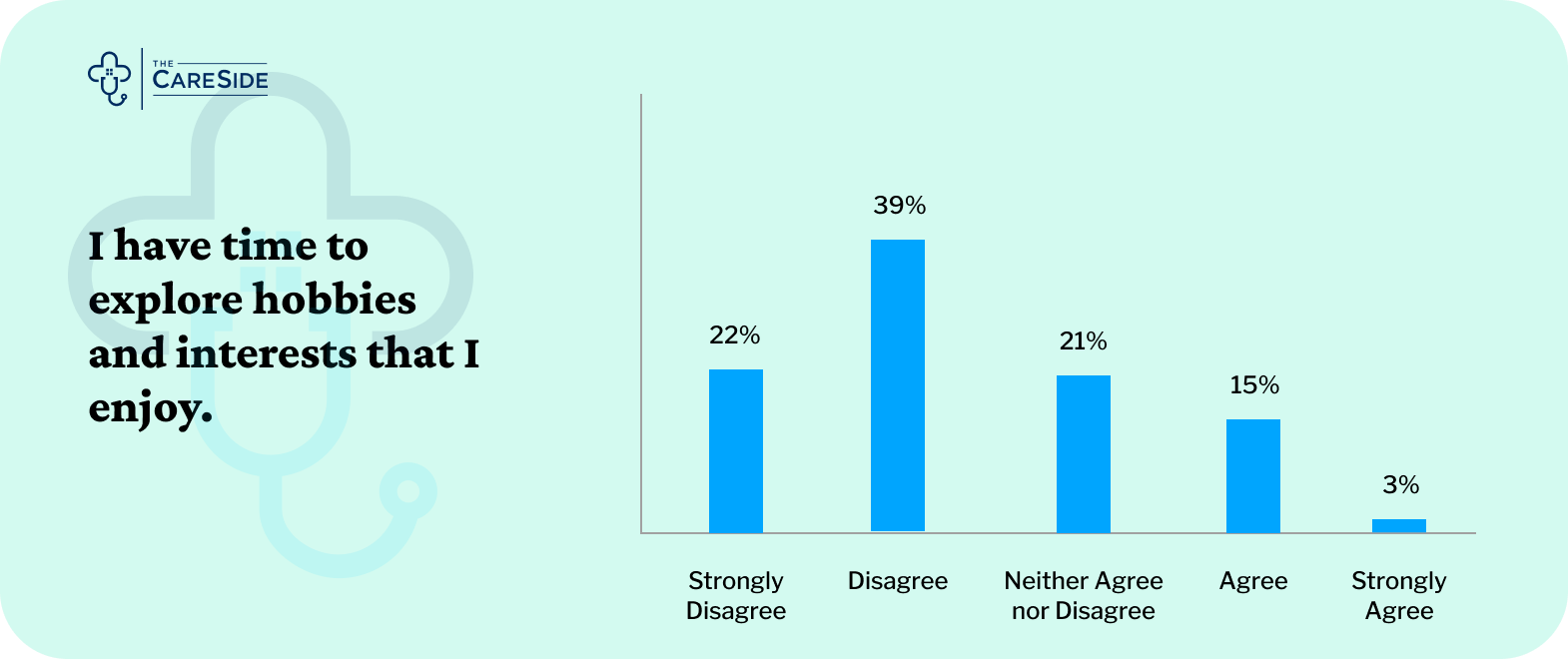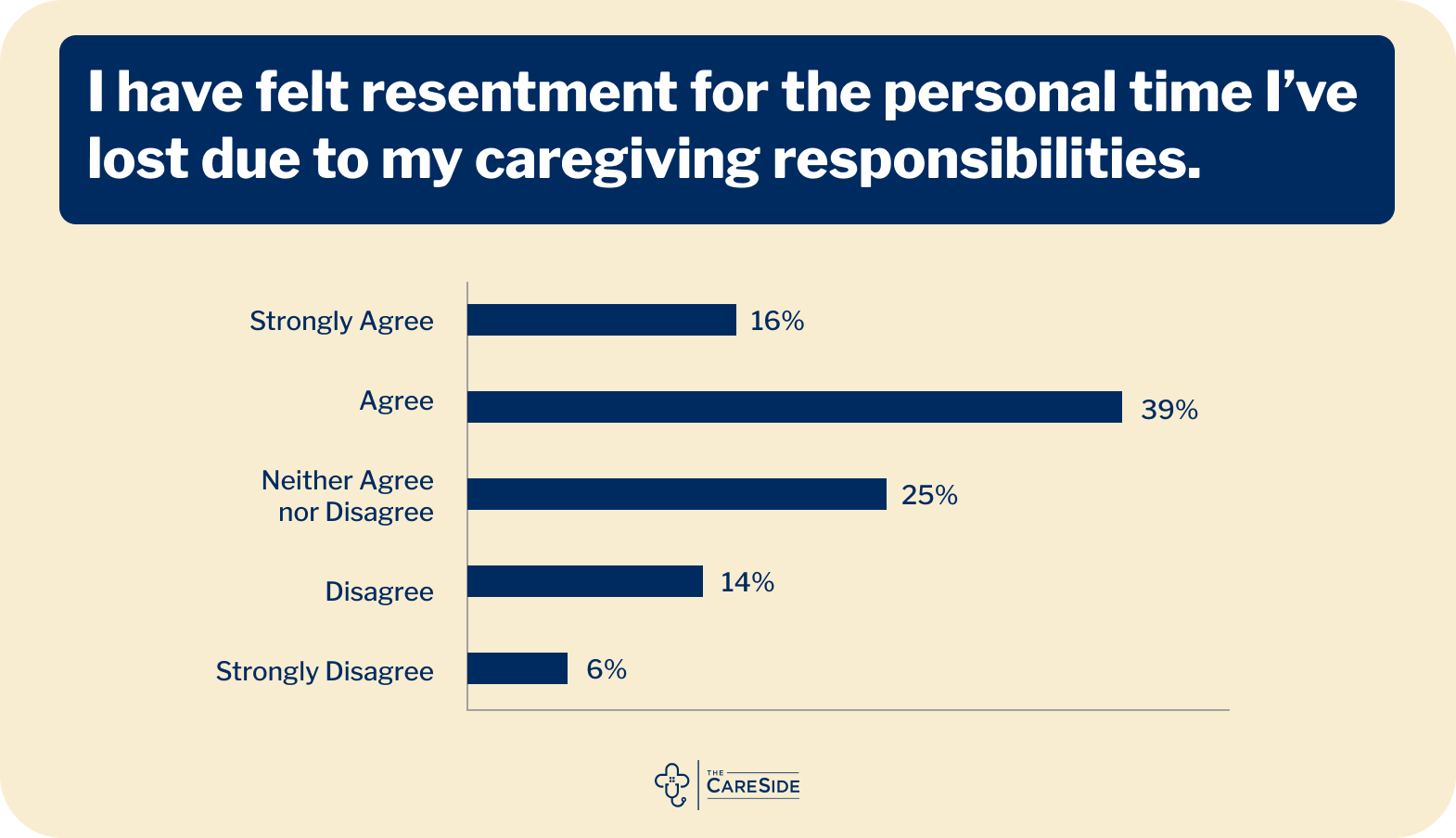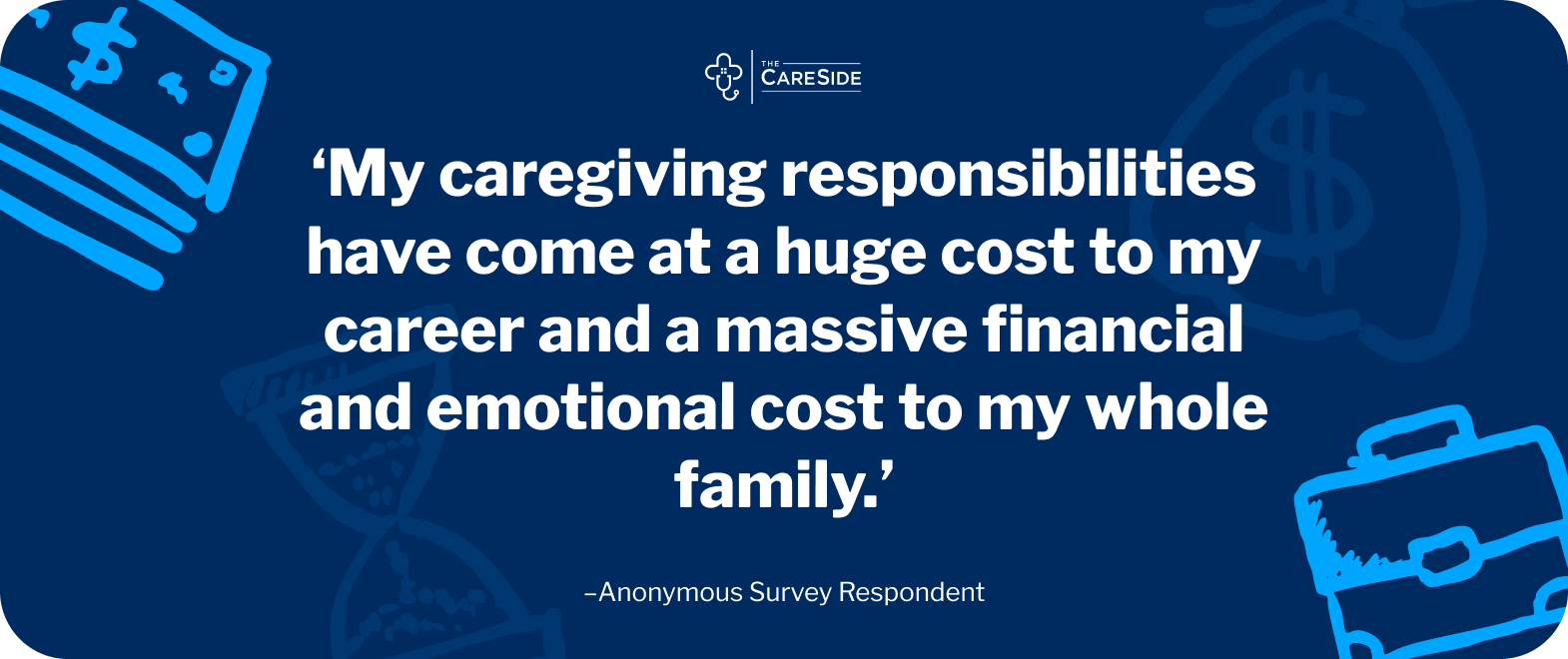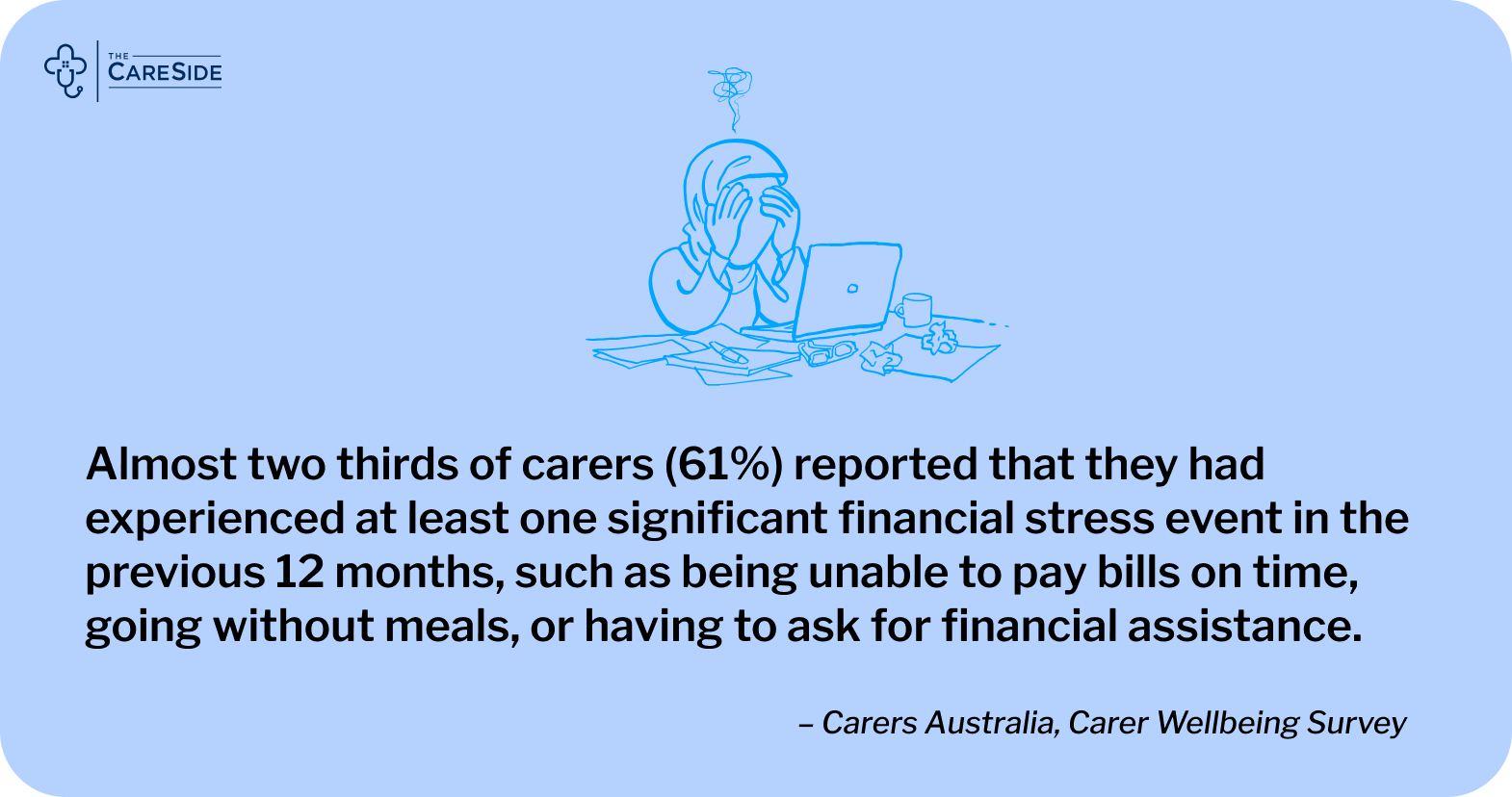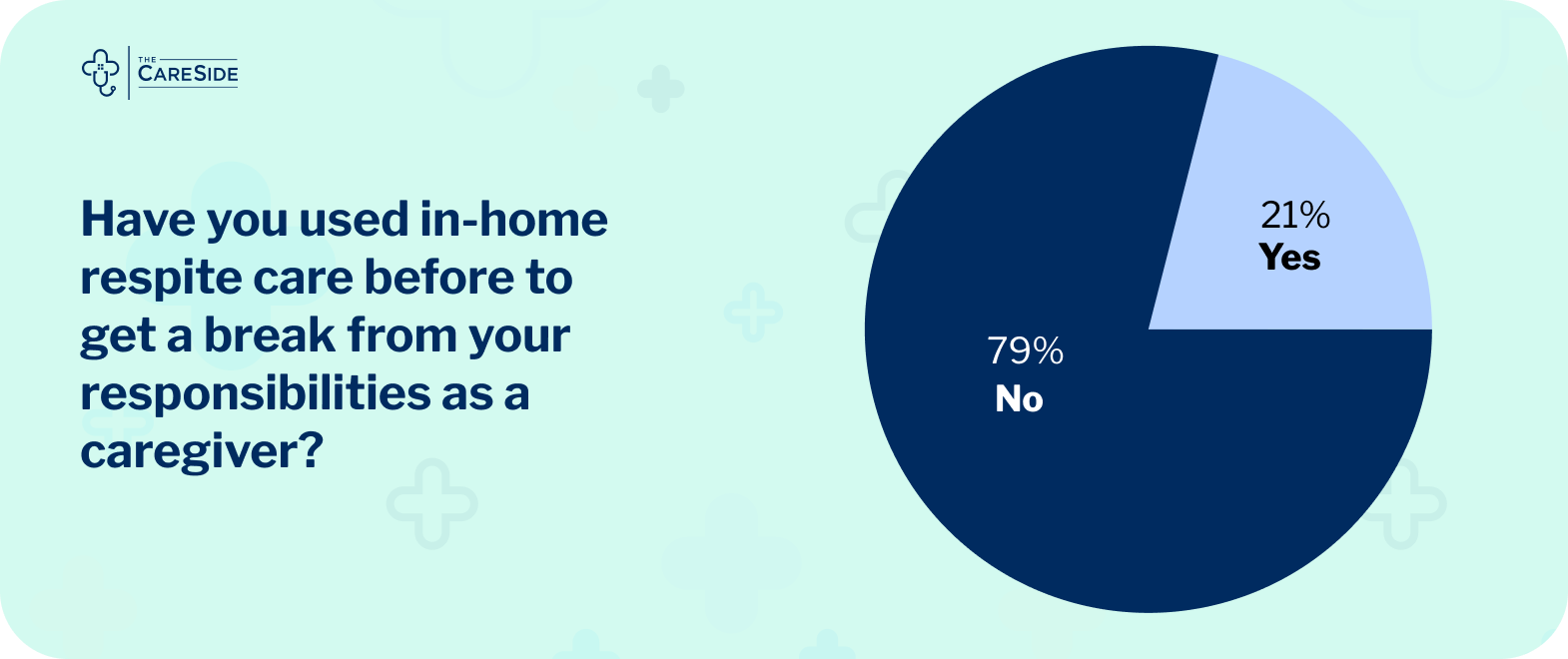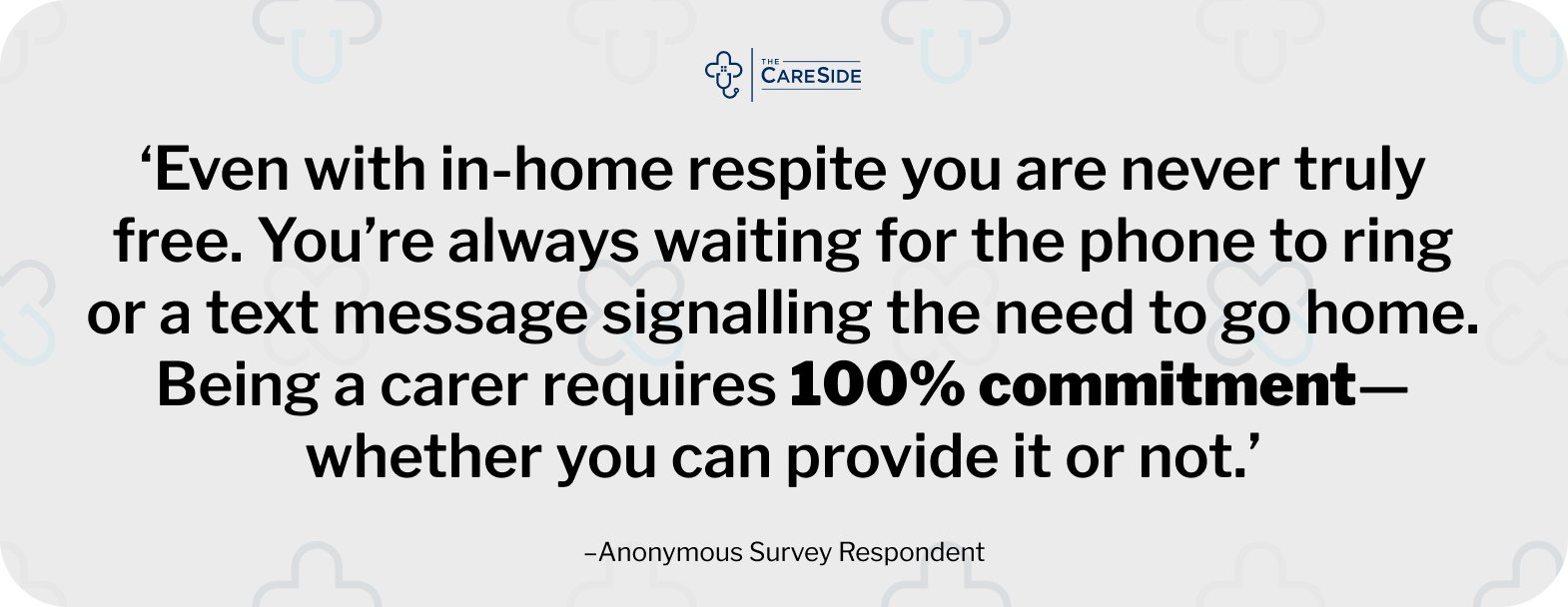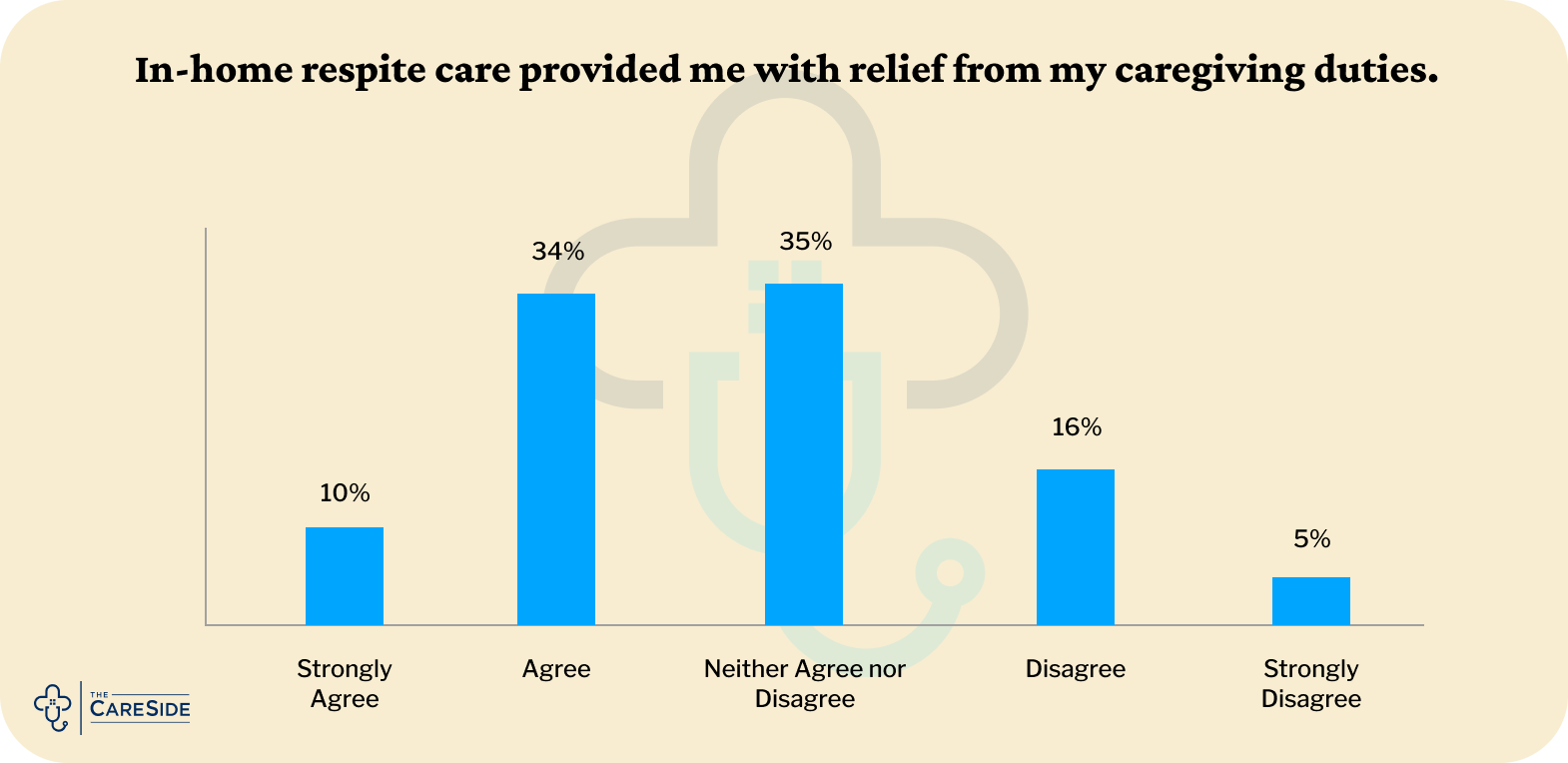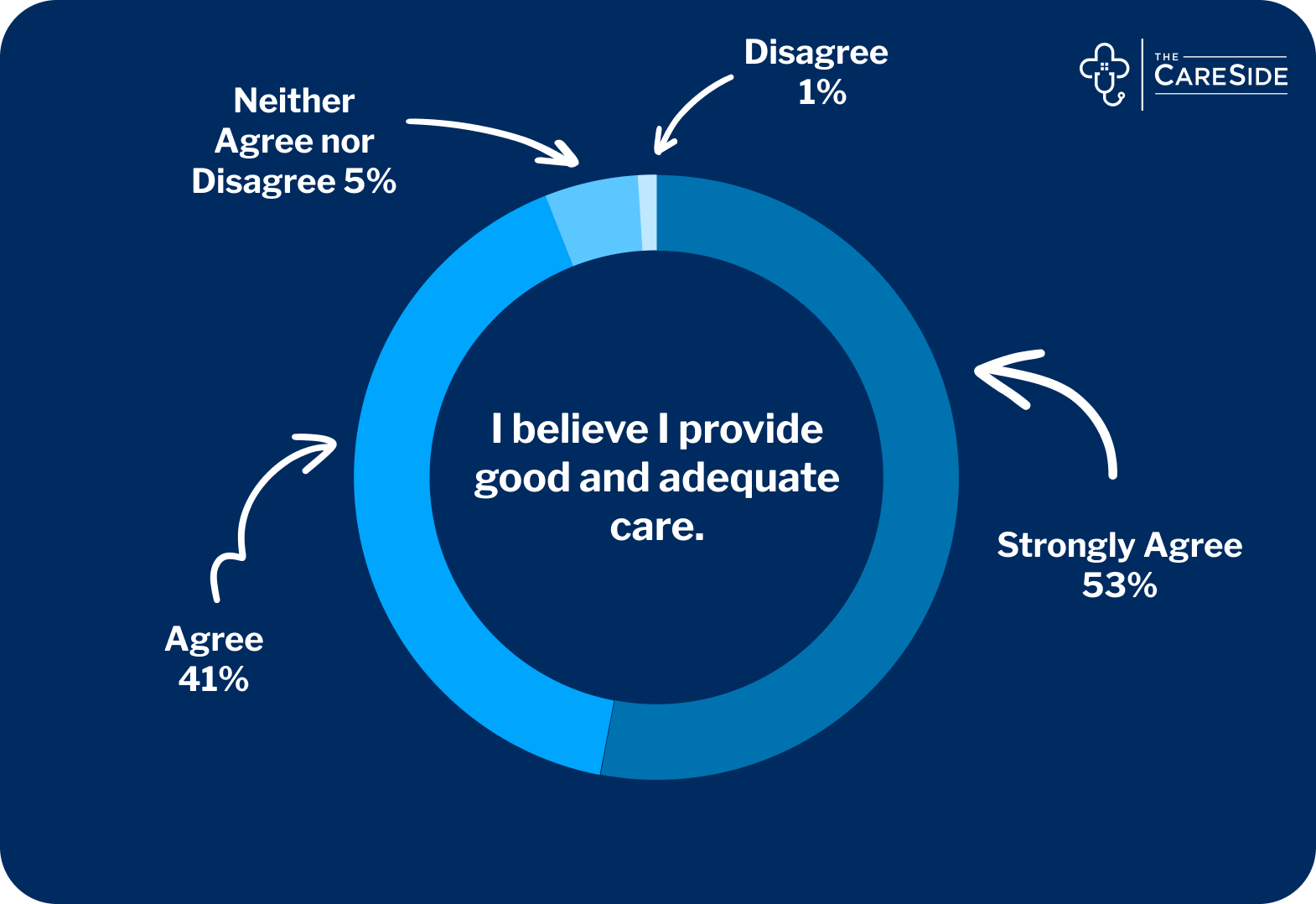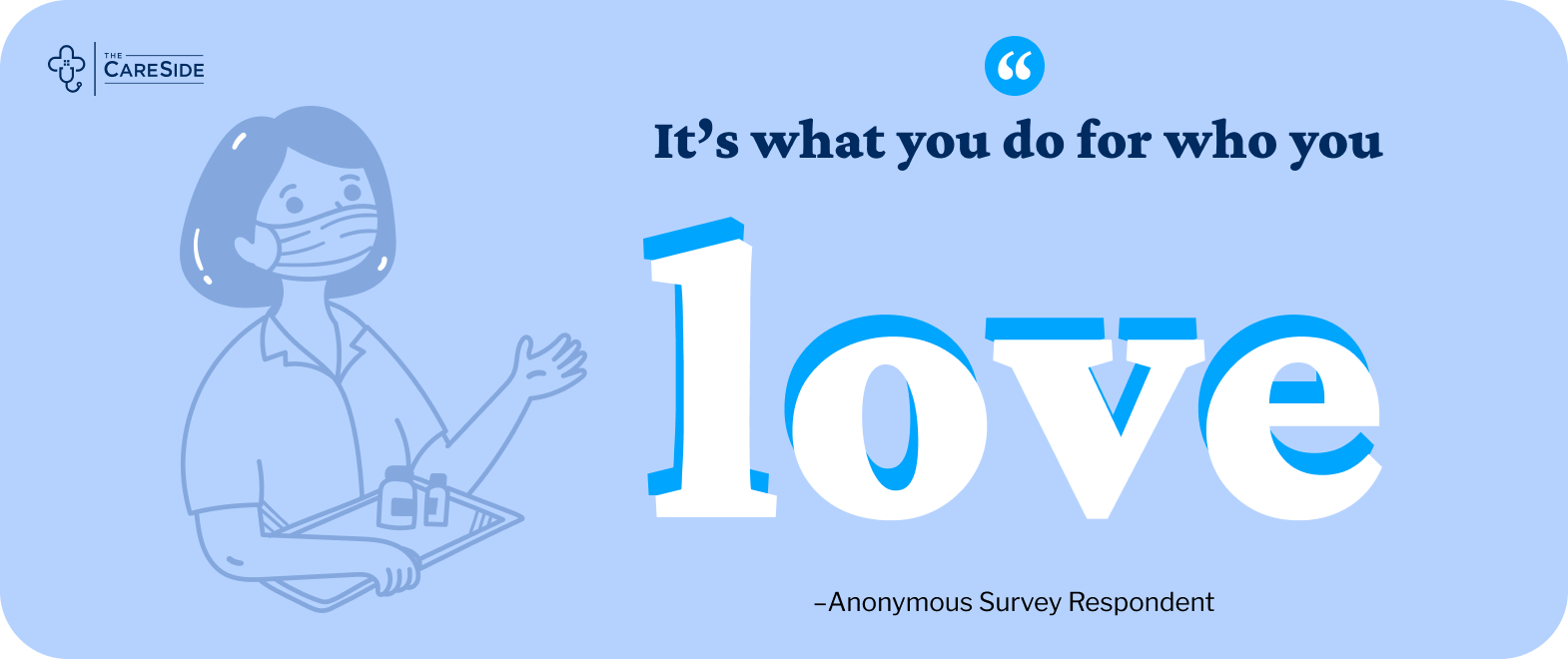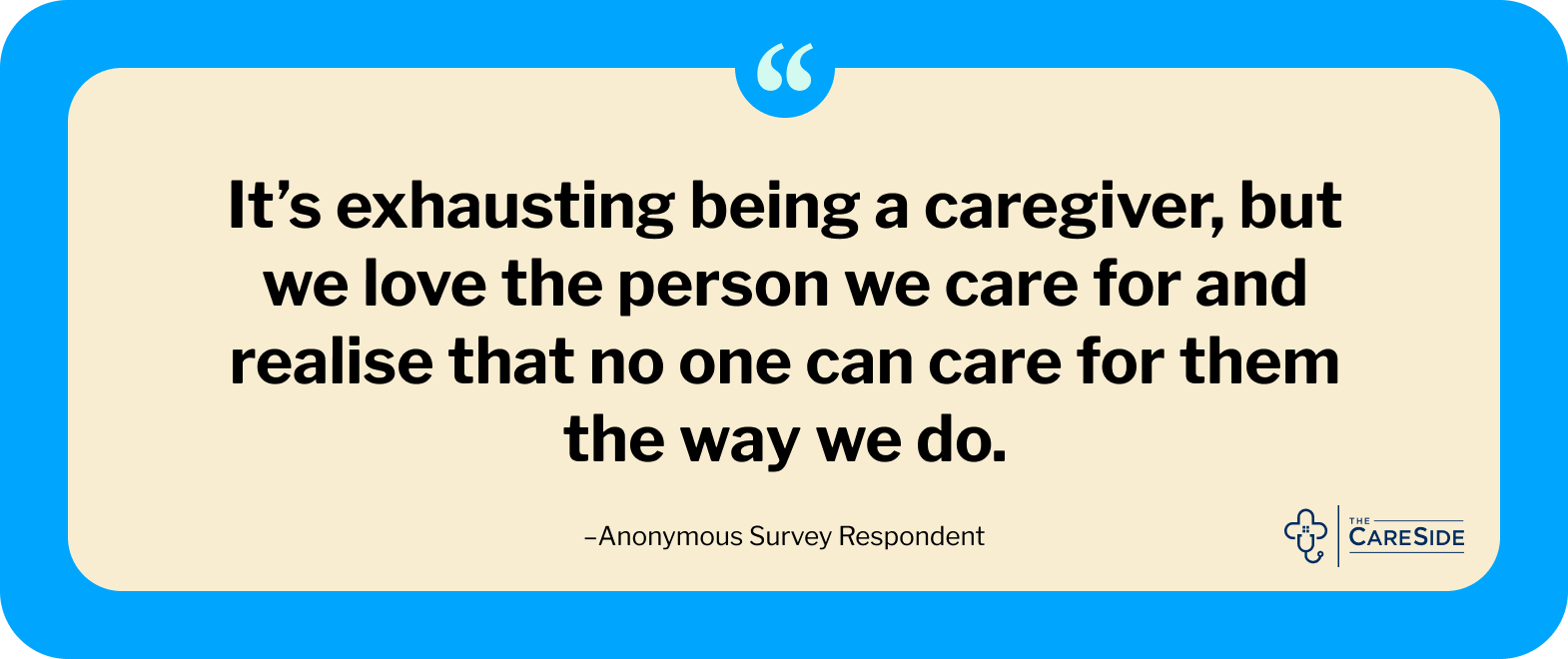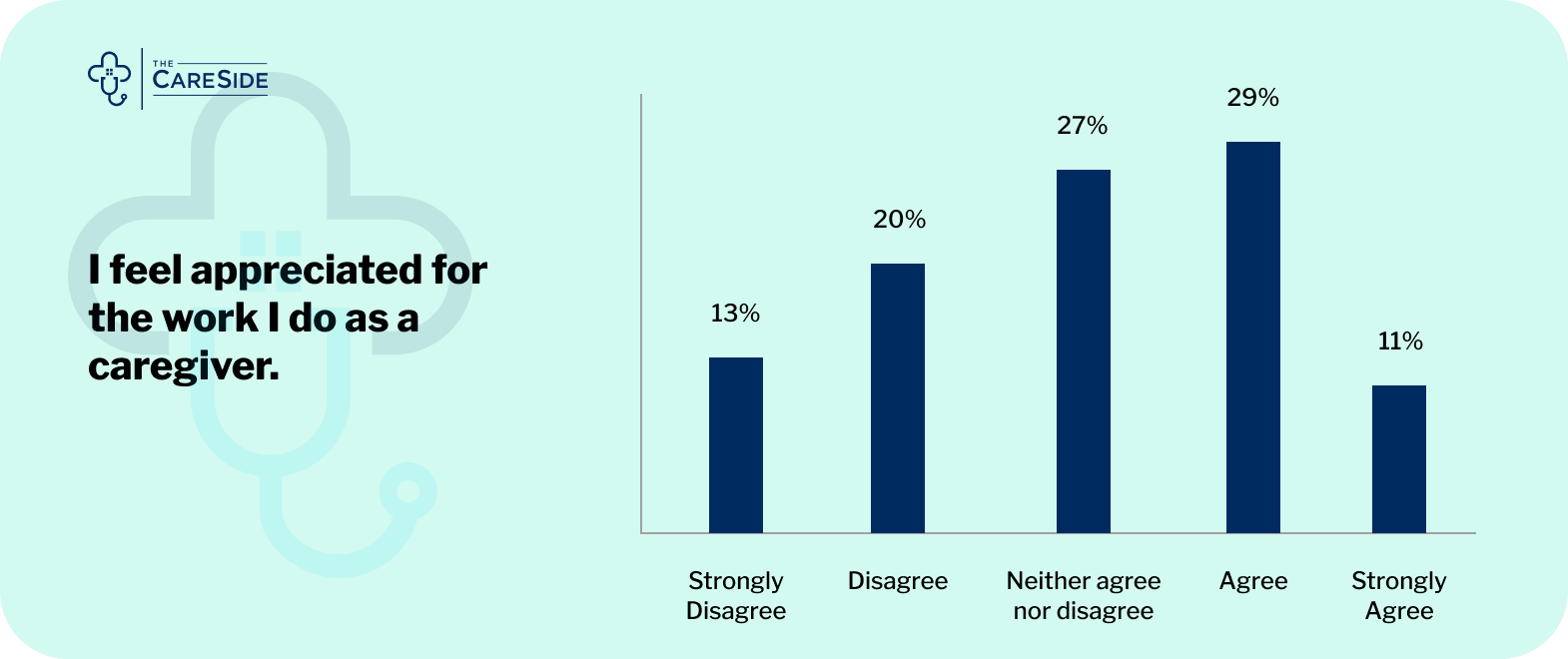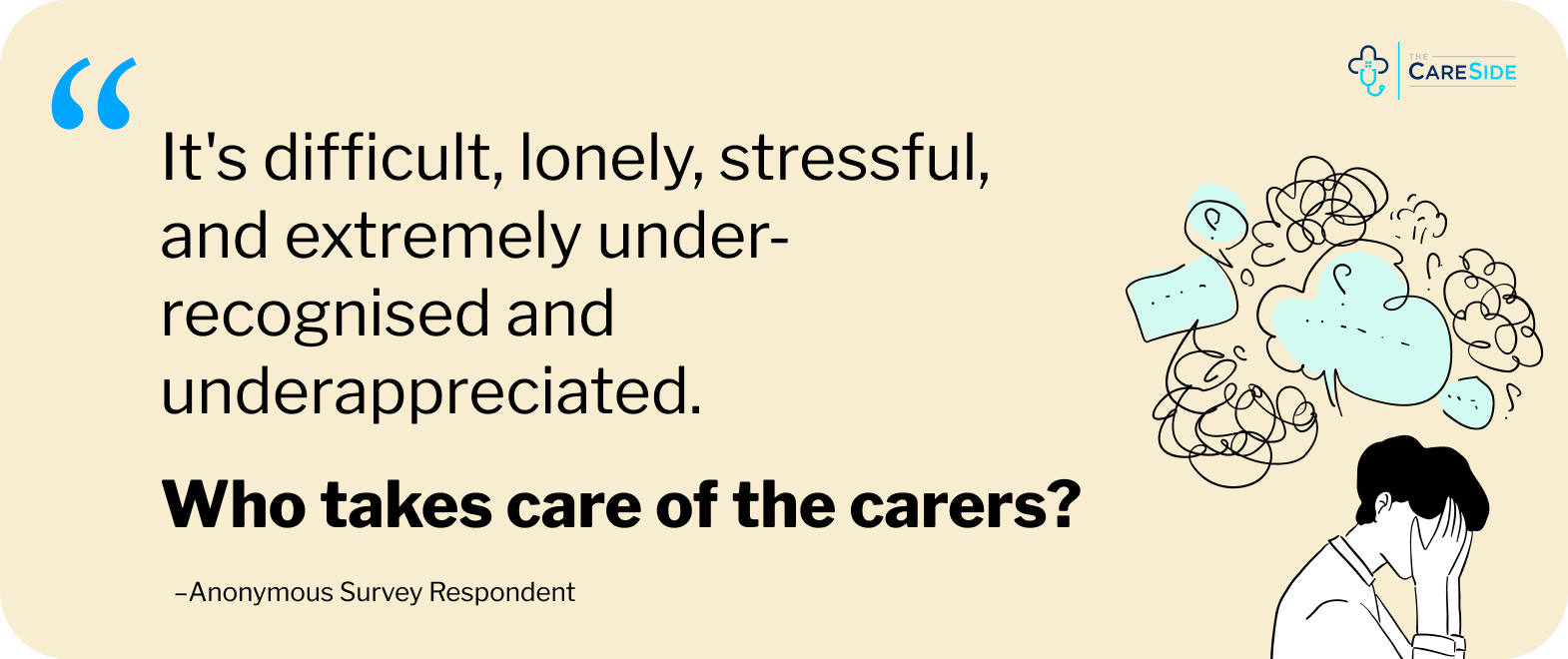
At a surface level, caregiving is a wholly admirable role.
But when you start to peel back the layers, it becomes obvious just how much caregiving demands from the people who do it regularly. There are physical requirements, to be sure, but the mental, emotional, and even spiritual obligations of caregiving take a toll that largely goes unnoticed.
Carers Australia is a non-profit organisation that advocates for the country’s unpaid carers. According to their research, the work done by Australia’s 2.65 million unpaid caregivers is the equivalent of nearly $78 billion in paid services annually.
Caregiving isn’t just a nice gesture; it’s become an indispensable part of Australia’s healthcare system. At The CareSide, we’ve always had unwavering support for caregivers—we know how challenging their roles are, and we know those challenges can lead to burnout. However, we only had anecdotal evidence supporting that stance and wanted to dig deeper.
How prevalent is caregiver burnout?
How do caregivers feel about their work, and what can be done to support them?
We conducted a research study to uncover some of the answers and give the general public a glimpse into the world of unpaid caregiving. Hopefully, the data presented in this report generates a greater appreciation for the sacrifices unpaid caregivers make and the essential work they do.
Summary of findings
- 94% of surveyed caregivers said they often feel physically or mentally exhausted due to their caregiving responsibilities.
- 92% reported they often neglect their own needs, while only 18% said they have time to explore hobbies and interest
- In many cases, caregiving is more than a full-time job. 41% of respondents said they spend 60 hours or more per week acting as a caregiver.
- Only 21% of respondents said they have used in-home respite care to get a break from caregiving obligations.
- 91% of caregivers surveyed are women, which highlights gender inequities related to domestic responsibilities.
- Despite its challenges, 41% feel fulfilled by their role as a caregiver—likely because of a strong conviction that the work they do matters. An overwhelming majority (94%) believe they provide good care.
About the study
For this report, we surveyed 707 unpaid caregivers living in Australia between November and December of 2023. The respondents were 91% female and 9% male.
In the interest of full disclosure, we anticipated a female majority. However, the stark discrepancy warrants a larger discussion. Even as gender equality in the workplace slowly improves, larger gains will be stunted as women continue to bear a disproportionate amount of domestic responsibility.
Age was also an instructive factor in our survey.
Only 6% of respondents were younger than 44 years of age; in fact, 75% of respondents were 55 years or older, and 40% were 65 or older. It might not come as a surprise, then, that 40% of the caregivers we surveyed reported caring for a spouse or partner. Another 38% cared for a parent or parent-in-law, and 21% cared for an adult child.
Given these demographics, it stands to reason that many respondents to this survey were providing care to spouses (or partners) afflicted with chronic conditions. That finding tracks with data from the Australian Institute of Health and Welfare, which reports that 80% of Australians aged 65 and older have at least one chronic health condition, and 28% have three or more chronic conditions.
Indeed, Australians are generally living longer lives compared to past generations, but many of them do so while navigating serious diseases they can’t possibly manage independently. Behind the curtain, unpaid caregivers are delivering care at a seemingly unsustainable rate—and the data suggests that many of them are managing health conditions of their own on top of it.
Caregivers are burnt out
In our survey, 94% of respondents either agreed or strongly agreed that they were often physically or mentally exhausted due to their responsibilities as a caregiver.
Caregivers in Australia are experiencing high burnout levels.
These numbers speak for themselves, but many of our respondents also opted to anonymously share their feelings in writing.
Such high levels of burnout make sense because, for many people, caregiving isn’t just a full-time job—it’s actually a bigger commitment. More than 40% of our survey respondents provide 60 hours of unpaid caregiving work or more every week, and another 13% checked in above the typical 40-hour work week threshold.
Caregiving isn’t typically just a part-time commitment—and it’s not a short-term one, either. Many unpaid caregivers provide their services for years at a time, including the 51% of respondents in our survey who have provided care for more than 5 years.
Generally, caregiving responsibilities predominate several hours a day, every day of the week, for years at a time. For many carers in Australia, it’s an even larger commitment; when you acknowledge caregiving through the lens of literal non-stop work, burnout seems less like a possibility and more like a foregone conclusion.
Carers Australia—the organisation that we mentioned at the top of this report—conducts an annual Carer Wellbeing Survey. In 2023, the study polled nearly 6,000 Australians and revealed caregivers are almost twice as likely (58%) to report low wellbeing compared to other adults (30%). Caregivers were also significantly less likely to have good or excellent health (19%) compared to other Australians (48%).
Caregiving presents an odd dichotomy. It is undoubtedly an act of love that inspires people to be the best versions of themselves, but it can also be a relentlessly demanding role that erodes the carer’s own physical, emotional and mental health over months and years of servitude.
In our research for this report, we learned caregivers regularly hold themselves to impossibly high standards, no matter who they are or where they’re from. Many unpaid caregivers feel obligated to constantly give more, even if it comes at the expense of their own health and wellbeing.
That’s the caregiving catch-22.
Unpaid caregiving leaves no time for self-care
Caregivers dedicate so much time and energy to the wellbeing of others that they disregard their personal health and happiness—and sometimes even their livelihood. In our survey, 92% of the respondents either agreed or strongly agreed that they often neglect their own needs because of caregiving responsibilities.
That disregard isn’t so much a choice as it is a necessity. Unpaid caregivers simply don’t have time to do the things they want (or need) to do, whether it’s caring for themselves or pursuing other endeavours. More than 60% of our respondents reported not having enough time to explore hobbies and interests they enjoy due to their caregiving obligations.
Even if there were more hours in the day, it stands to reason that a large percentage of carers might spurn those activities anyway. A loss of interest in previous hobbies and passions is a telltale symptom of stress and burnout. Fatigue and sleep issues (either sleeping too much or not enough) go hand-in-hand with that dwindling desire, creating a snowball effect of poor personal-care habits. Other symptoms of caregiver stress can include:
- Anxiety, depression and feelings of isolation, anger or frustration
- Strained relationships with family members and friends
- Feelings of burden and worry
- Unwanted weight loss or weight gain
- Misuse of alcohol and/or drugs (including prescription medications)
- Headaches, bodily pains and other health problems
These symptoms are all part of the bigger caregiver burnout story, even if they don’t explicitly affect each individual. Perhaps unsurprisingly, many caregivers endure some level of irritation about their unbalanced lifestyle. More than half of our survey respondents (55%) reported feeling resentment in regards to the personal time they’ve lost.
If we step back, we can concede that outside hobbies and interests are often casualties of busy lifestyles—that’s not necessarily a challenge unique to caregivers.
However, the trend becomes problematic when you consider unpaid caregivers need to earn an income like everyone else. The care-work-life equation can be much more complicated than a standard work-life balance, and its demands have the potential to squeeze even fundamental aspirations—such as holding down a steady job or career advancement—out of the picture.
Because of that, a growing number of unpaid caregivers are struggling financially.
In the Carers Australia 2023 annual survey, data revealed caregivers were 1.6 times more likely to experience significant financial stress compared to other Australians.
Hobbies and interests are often nice-to-haves in the lives of busy people. But unpaid caregiving and the potential burnout that accompanies it casts a much larger shadow than that. It has implications on self-care, to be sure, but even more alarmingly it’s beginning to have a staggering economic impact on the livelihoods of Australians who have been thrust into caregiving roles.
Ultimately, this data makes it abundantly clear our healthcare system depends on the efforts of people who don’t get paid for their work and, for the most part, operate behind the scenes with minimal recognition. And make no mistake: as fulfilling as it can be, caregiving is work, and its inherent challenges have many people across the country feeling stretched past their limit.
Respite care: An under-utilised tool in unpaid caregiving
Fortunately, unpaid caregivers have certain levers at their disposal they can pull when they need help.
Respite care is one of those levers. By design, respite care is supposed to give primary caregivers a short reprieve from their caring duties so they can address their own needs and establish a healthier balance.
As you can probably deduce from the data presented thus far, many unpaid caregivers don’t take a break from their caregiving responsibilities until they’re forced to by health crises of their own. Respite care is a flexible tool that can take place in the care recipient’s home, at a residential care facility or at a designated community centre. It can be several hours a week, or it can be stretched out while primary carers go on holiday.
Considering everything we know about the demands of unpaid caregiving, conventional wisdom points to respite care being a very popular service in Australia. Residential care facilities and designated community centres are prominent options, but based on our survey results, in-home respite care appears to lag behind.
Adam Birch is a counselling team leader for Carers WA, where he provides therapeutic support to caregivers through counselling, workshops and support groups. We recently interviewed Adam about caregiver burnout, and when we asked him about this particular result in our survey, he told us many caregivers struggle with the concept of respite care because it pulls them away from what they feel they’re supposed to be doing—delivering the care themselves.
‘Even if carers move towards respite options, they may feel like they’ve failed or they might encounter resistance from the care recipient,’ Birch said. ‘Respite options need to be utilised as a preventative strategy to burnout, not because burnout is already happening.’
The temporary nature of in-home respite care also seems to give some caregivers pause. It almost becomes an issue of, ‘What’s the point?’
Many caregivers are never truly off the clock, even when they leave the location where they provide care; they feel they always need to be on duty, so they never entertain the option of in-home respite care or explore resources that might give them temporary reprieve. Respite care can also be quite expensive for care recipients who don’t have a home care package, and those lofty out-of-pocket costs make it a non-starter.
The unpaid caregivers in our survey who have utilised in-home respite care reported it was more helpful than not. Nearly half of them (44%) either agreed or strongly agreed that in-home respite care provided them with relief from their caregiving duties.
Those numbers suggest in-home respite care does indeed accomplish what it’s designed to do. Still, while this particular lever offers relief to many carers in Australia, it probably isn’t a silver bullet solution to overall caregiver burnout.
Despite challenges, unpaid caregiving can be fulfilling
Caregiving is a tangled web with many complicated factors, including financial stresses, logistical dilemmas, time crunches, personal sacrifices, and of course, health crises that make caregiving a necessity to begin with.
But what happens when we strip all of that away?
At its core, caregiving is an act of love. It might be an unexpected circumstance, and it might be burdensome in a multitude of ways, but the solitary act of caregiving has a very sincere heartbeat that’s easy to lose in the bustle of everything else.
Despite the challenges, the overwhelming majority of caregivers in our survey believed they were doing a good job. More than 9 out of 10 respondents agreed or strongly agreed that they provide good and adequate care.
Many of them echoed those sentiments with genuinely inspired written comments, which again, were shared anonymously through the survey.
Caregiving is unquestionably a fulfilling role.
But what we’ve found through our research is the rewarding aspects of caring for a loved one can be muffled or drowned out completely by the day-to-day grind—not to mention, the reality of the situation, which generally involves distressing health conditions and a lot of uncertainty.
Ultimately, unpaid caregivers do what they do out of the goodness of their hearts but many of them feel unsupported, unrecognised and unappreciated. Those feelings are only compounded by the fact that unpaid caregiving is just that—unpaid—leaving carers across Australia adrift, with little positive feedback and no monetary compensation for all of the work they do.
Unpaid caregiving has not only become a critical part of Australia’s healthcare system, it’s vital to the function of our society. We mentioned these numbers up top, but they bear repeating: there are 2.65 million unpaid carers in Australia, which is nearly 11% of the population.
The work done by those millions of people is the equivalent of roughly $78 billion in annual paid services. It’s unnerving to consider a world without dedicated unpaid caregivers—what would that mean for their care recipients? Where would the other 89% of us be without unpaid caregivers operating quietly behind the scenes?
Proper support and recognition are long overdue, and while there’s no obvious answer as to what that looks like, the conversation has to start somewhere. It also has to start soon, because based on the results of this and other studies, unpaid caregivers are burnt out.
Methodology
This survey was conducted by The CareSide between November and December 2023. Responses were collected from 707 unpaid caregivers living in Australia. The data was collected via social media promotions and advertising.


